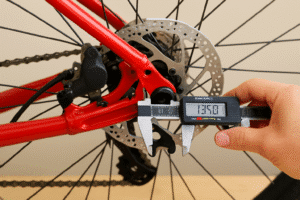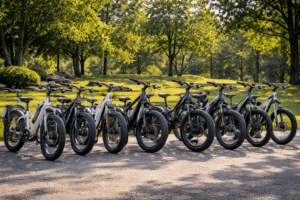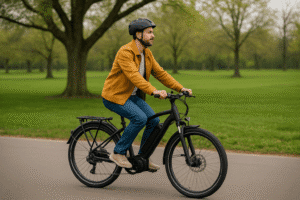Electric dirt bikes are growing in popularity, but whether you can ride one on the road depends on the model and your local laws.
Some are built for street use, while others are strictly off-road machines. Understanding the difference can save you from tickets, fines, or even having your bike impounded.
Key Takeaways:
- An electric dirt bike can be ridden on the road only if it’s street legal under your local laws.
- Street-legal models come with required gear like lights, mirrors, and DOT-approved tires.
- Off-road-only bikes are limited to private property and designated trails.
- Converting to street legal is possible in some states, but not allowed everywhere.
What is an Electric Dirt Bike?
An electric dirt bike is a two-wheeled vehicle with an electric motor designed for off-road riding on dirt trails, tracks, or rugged terrain.
Unlike regular e-bikes, electric dirt bikes typically have higher top speeds, stronger motors, and off-road tires.
They use rechargeable batteries instead of gasoline, making them quieter and easier to maintain. Many models resemble small motorcycles and are built for agility on uneven ground.
While they share some similarities with electric mountain bikes, the main difference is that dirt bikes are usually throttle-controlled and lack pedals.
This design gives them more power but also means they may not qualify as bicycles under the law. Whether you can take one onto public roads depends on how it’s equipped and classified.
Can You Ride an Electric Dirt Bike on the Road?
You can ride an electric dirt bike on the road only if it is street legal and meets your local vehicle requirements. If your bike was sold as “off-road only,” it cannot be ridden on public streets without modifications and legal registration.
Street-legal electric dirt bikes come with features like headlights, brake lights, mirrors, and DOT-approved tires. You may also need a motorcycle license, registration, and insurance, depending on your state or city.
Riding a non-compliant bike on public roads can lead to fines or confiscation, so it’s important to check the rules before you ride.
Street Legal vs. Off-Road Only
Street-legal electric dirt bikes meet safety, equipment, and licensing requirements for public road use, while off-road models do not.
Here’s what typically separates the two:
Street Legal
- Has headlights, brake lights, turn signals, mirrors
- Equipped with DOT-approved tires
- Meets speed and noise limits for on-road use
- Registered and insured if required by law
Off-Road Only
- Lacks road-required lighting and safety gear
- Uses off-road tires not approved for street use
- May exceed legal noise or speed limits for public roads
- Not registered or insured for street operation
Some riders convert off-road models into street-legal bikes, but the process can be costly and time-consuming, and it’s not allowed in every state.
U.S. Road Rules for Electric Dirt Bikes
In most U.S. states, electric dirt bikes are classified as motorcycles, mopeds, or off-highway vehicles, not as standard bicycles.
The exact rules vary, but generally:
- If your bike can exceed 28 mph and lacks pedals, it is treated as a motor vehicle.
- Most states require registration, insurance, and a motorcycle license for road use.
- Off-road models can only be used on private land or designated trails.
Many states follow the three-class e-bike system, but this typically applies to pedal-assist bikes, not throttle-controlled dirt bikes.
This means even if your electric dirt bike is quiet and zero-emission, it may face the same regulations as a gas-powered motorcycle.
Always check your state’s Department of Motor Vehicles website for current laws before riding on public streets.
How to Make an Electric Dirt Bike Street Legal
You make an electric dirt bike street legal by adding the required road equipment, passing any inspection your state requires, and then registering, plating, and insuring it like a moped or motorcycle.
Here’s the step‑by‑step process I use:
- Confirm it’s convertible: Check your state DMV site first. Some states do not allow converting an off‑highway vehicle for street use. If they do, learn which class it will fall under.
- Paperwork check: Make sure you have a Manufacturer’s Statement of Origin or title. If the frame doesn’t have a VIN, ask your DMV about a VIN assignment process.
- Add the required equipment:
- Headlight with high and low beam
- Taillight and working brake light
- Front and rear turn signals
- At least one mirror, often two
- Horn
- License‑plate bracket with plate light
- DOT‑approved tires
- Speedometer/odometer if your state requires it
- Reflectors as specified by your DMV
- Wire and test everything: Verify lights, signals, and horn work with the key on and while braking. Secure wiring away from heat and moving parts.
- Inspection (if required): Some states need a safety or VIN inspection. Bring receipts for parts and your ID.
- Register and insure: Get a plate and pay fees. Many states also require liability insurance.
- Get the right license: If it’s classified as a motorcycle, you’ll likely need a motorcycle endorsement. If it’s a moped, a regular license may be enough.
Pro tip: Keep your stock off‑road wheels and tires for trail days, and a DOT set for street days. Swapping wheels is often faster than remounting tires.
Where You Can Ride if It’s Not Street Legal
If your bike is off‑road only, keep it off public streets and stick to legal riding spots.
- OHV parks and trails: State OHV areas, national forest motorized trails, and BLM routes that allow dirt bikes.
- Motocross tracks: Closed‑course tracks and practice facilities welcome dirt‑focused setups.
- Private property: Ride with the owner’s permission and be mindful of neighbors.
- Events and camps: Organized ride days, enduro loops, and training camps often list e‑dirt bike-friendly sessions.
- What to avoid: Public roads, bike lanes, sidewalks, and shared‑use paths unless your bike is plated and allowed by local law.
Alternatives if Full Road Use Isn’t Allowed
Want the dirt‑bike vibe without the legal headache? These options keep the look and feel while staying compliant.
- Street‑legal electric motorcycles: Built for pavement out of the box with all required equipment and VINs.
- Electric mopeds and scooters: Lower speed caps, lighter weight, easier licensing in many states.
- E‑moto style e‑bikes with pedals: Class 2 or Class 3 designs that keep the moto look but fit e‑bike rules in many cities.
- Dual‑sport approach: Own two wheelsets or two bikes, one for trails and one factory street‑legal for commuting.
Final Words
You can ride an electric dirt bike on the road, but only if it’s truly street legal under your local rules. Start with your DMV page, add the right equipment, pass any inspection, then plate and insure it.
If conversion isn’t allowed where you live, ride legal off‑road spots or pick a street‑legal alternative that suits your speed and license needs.
If you’re shopping next, check our tested picks in our best electric dirt bike roundup. It will help you find the right bike for both fun and your local rules.
FAQs
Can police tell if my dirt bike is over the speed limit?
Yes. While they can’t always tell by looking at it, police can use radar or pacing to measure your actual speed. If your bike is registered, they may also know the manufacturer’s top speed and check if it exceeds local limits.
Do I need a motorcycle license for an electric dirt bike?
In most states, you will need a motorcycle license if your electric dirt bike is classified as a motorcycle. Lower-speed models that meet moped or e-bike definitions may have different requirements, but you’ll still need to follow your state’s licensing rules.
Can I ride one in bike lanes?
No, not if it’s a throttle-controlled dirt bike without pedals or if it exceeds e-bike speed limits. Bike lanes are typically reserved for bicycles and legal e-bikes, and motorized vehicles like dirt bikes are usually prohibited.
Are there street-legal dirt bikes under 30 mph?
Yes. Some manufacturers make electric dirt bikes and moped-style models capped at 30 mph, which can be easier to register and may have simpler licensing requirements. These are often marketed for urban commuting.
Can you convert any off-road e-dirt bike to street legal?
Not always. Some states prohibit converting off-highway vehicles for street use, even with all the right equipment. Where it is allowed, you’ll need to add the required safety gear, get an inspection, and register the bike.
Al Amin Morshed is the founder of BoltBikers and a seasoned e-bike reviewer with years of hands-on experience testing electric bikes. As a long-time e-bike enthusiast, he combines real-world riding insights with in-depth research to create honest, helpful content for riders of all levels. Through BoltBikers, Morshed aims to make e-biking more accessible, practical, and enjoyable – whether you’re a new rider or a daily commuter looking for the best gear.








